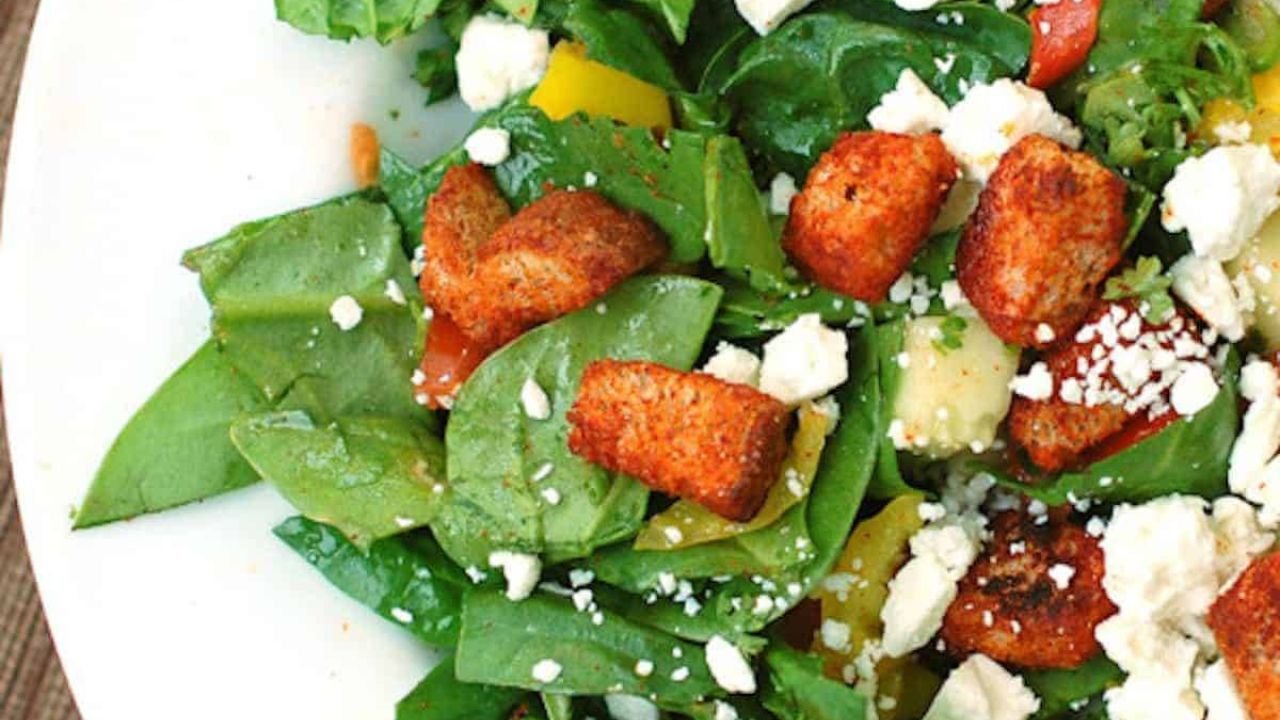Introduction
Greek cuisine is renowned for its vibrant flavors, fresh ingredients, and wholesome dishes that celebrate the Mediterranean lifestyle. Among its most iconic offerings is the Greek salad, known locally as Horiatiki, a dish that embodies simplicity, freshness, and bold flavors. Adding crunchy paprika-seasoned croutons elevates this classic, introducing a delightful contrast in textures and a smoky, spicy kick.
This comprehensive exploration delves into the origins, ingredients, preparation techniques, variations, health benefits, and cultural significance of Greek Salad with Paprika Croutons. Whether you’re a home cook seeking to perfect this dish or an enthusiast eager to understand its roots, this guide will enrich your culinary knowledge.
Historical and Cultural Context
Origins of Greek Salad
The Greek salad is a staple of Mediterranean cuisine, with roots tracing back centuries in Greek villages and towns. Traditionally, it features ripe tomatoes, cucumbers, red onions, Kalamata olives, feta cheese, and oregano, dressed simply with olive oil and sometimes a splash of lemon or vinegar.
Historically, the Horiatiki reflects the agrarian lifestyle of Greek farmers (horiates), utilizing fresh, seasonal produce readily available in the region. Its simplicity and emphasis on high-quality ingredients exemplify the Greek philosophy of kefi—joy in eating and sharing.
Evolution and Popularity
While traditional Greek salads are straightforward, modern adaptations have incorporated additional elements such as lettuce, bell peppers, or different cheeses. The addition of croutons—particularly seasoned with paprika—originates from contemporary culinary trends emphasizing texture contrast and flavor layering.
Paprika, a spice derived from dried and ground peppers, has its roots in Central Europe but is widely embraced in Mediterranean cooking. Its smoky, sweet, and spicy profiles enhance salads by adding depth and a visual pop of color.
Ingredients: Selection and Preparation
Core Ingredients of a Classic Greek Salad
- Tomatoes: Ripe, juicy, and flavorful; heirloom or vine-ripened varieties are preferred.
- Cucumbers: Fresh, crisp, and lightly flavored; English or Persian cucumbers are ideal.
- Red Onions: Thinly sliced for a mild, sharp bite.
- Kalamata Olives: Briny and flavorful, often pitted.
- Feta Cheese: Traditionally brined and crumbly, offering a salty, creamy taste.
- Oregano: Dried or fresh, for seasoning.
- Extra Virgin Olive Oil: The hallmark dressing ingredient.
- Lemon Juice or Red Wine Vinegar: Optional for added acidity.
- Salt and Pepper: To taste.
Additional Optional Ingredients
- Bell Peppers: For added sweetness and crunch.
- Lettuce or Greens: For variation and volume.
- Capers: For extra brine.
- Fresh Herbs: Parsley, mint, or dill for garnish.
Paprika Croutons: Ingredients and Preparation
Ingredients:
- Baguette or rustic bread slices
- Olive oil
- Paprika (sweet or smoked, based on preference)
- Garlic powder (optional)
- Salt
- Black pepper
- Dried oregano or thyme (optional)
- Parmesan cheese (optional for extra flavor)
Preparation Steps:
- Preheat Oven: To 375°F (190°C).
- Prepare Bread: Slice bread into ½-inch thick cubes or strips.
- Seasoning Mixture: In a small bowl, mix olive oil with paprika, garlic powder, salt, pepper, and herbs.
- Coat Bread: Toss bread cubes in the seasoned oil until evenly coated.
- Bake: Spread on a baking sheet in a single layer. Bake for 10-15 minutes, turning halfway, until golden and crispy.
- Optional: Sprinkle with grated Parmesan during the last few minutes for added flavor.
Step-by-Step Preparation of Greek Salad with Paprika Croutons
1. Preparing the Vegetables
- Tomatoes: Wash and cut into wedges or chunks.
- Cucumbers: Peel if desired, then slice into rounds or half-moons.
- Red Onions: Peel and thinly slice into rings.
- Olives: Pit and halve or leave whole.
- Feta: Crumble or cut into blocks if desired.
2. Assembling the Salad
- In a large mixing bowl, combine tomatoes, cucumbers, onions, and olives.
- Add crumbled feta on top.
- Season with dried oregano, salt, and freshly ground black pepper.
- Drizzle generously with extra virgin olive oil.
- Squeeze fresh lemon juice or add a splash of red wine vinegar for acidity.
- Gently toss to combine, ensuring the feta remains crumbly and the vegetables are coated evenly.
3. Preparing and Adding the Croutons
- Immediately before serving, add the paprika croutons to maintain their crunch.
- Toss lightly to distribute evenly.
4. Serving
- Garnish with fresh herbs if desired.
- Serve immediately to enjoy the contrasting textures of crunchy croutons and crisp vegetables.
Variations and Modern Twists
1. Vegan Greek Salad
- Replace feta with vegan cheese or omit cheese altogether.
- Use plant-based olives and ensure the bread is vegan.
2. Grain-Enriched Salad
- Add cooked quinoa, bulgur, or couscous for a filling variation.
3. Additional Toppings
- Sliced roasted red peppers
- Capers or anchovies
- Fresh herbs like parsley, mint, or dill
4. Spicy or Smoky Variations
- Use smoked paprika for a deeper smoky flavor.
- Add hot sauce or chili flakes to the crouton seasoning for heat.
5. Mediterranean Fusion
- Incorporate ingredients like artichoke hearts, sun-dried tomatoes, or roasted eggplant.
Nutritional Profile and Health Benefits
Fresh Vegetables
Rich in vitamins (A, C, K), minerals (potassium, magnesium), and antioxidants, contributing to overall health.
Feta and Olives
Provide healthy fats, calcium, and protein. Olives are high in monounsaturated fats and antioxidants.
Olive Oil
A primary source of healthy monounsaturated fats, supporting heart health.
Paprika Croutons
Offer flavor and crunch with minimal calories; smoked paprika contains antioxidants like carotenoids.
Overall
This dish is a nutrient-dense, balanced meal emphasizing fresh produce, healthy fats, and flavor complexity.
Cultural Significance and Contemporary Appeal
Embracing Simplicity
The Greek salad epitomizes the Greek culinary philosophy—simple ingredients, vibrant flavors, and shared meals.
Modern Adaptations
Chefs worldwide elevate the classic with creative additions like grilled proteins, new dressings, or fusion ingredients, while maintaining its core identity.
Popularity
The dish’s health benefits and fresh flavors make it a favorite among health-conscious consumers and those seeking light, flavorful meals.
Serving Suggestions and Pairings
- Beverages: Dry white wines like Assyrtiko, rosé, or refreshing mineral water with lemon.
- Side Dishes: Grilled vegetables, spanakopita, or pita bread.
- Main Course: Pair with grilled seafood or chicken for a complete Mediterranean feast.
- Desserts: Fresh fruit, yogurt with honey, or baklava.
Sustainability and Ethical Considerations
- Use locally sourced, organic produce to support sustainable farming.
- Choose environmentally friendly packaging for bread and ingredients.
- Support local artisans and farmers for authentic and eco-conscious products.
Conclusion
Greek Salad with Paprika Croutons is a celebration of Mediterranean freshness, texture, and flavor harmony. Its roots in Greek tradition emphasize the importance of high-quality, seasonal ingredients, while the addition of paprika croutons introduces a modern twist, balancing crunch and smoky spice.
This dish exemplifies how simple ingredients, when thoughtfully combined, can create a memorable and nutritious meal. Whether served as a starter, side, or light main course, it embodies the essence of Greek culinary philosophy—fresh, flavorful, and shared with joy.
By understanding its ingredients, preparation techniques, and cultural backdrop, home cooks can recreate an authentic Greek experience in their own kitchens, adding their personal touch to this timeless classic.

